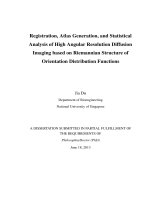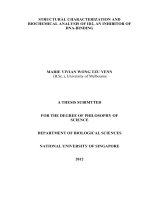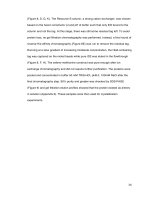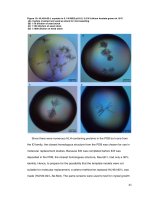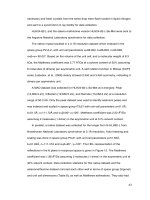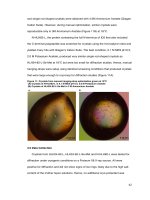Mathematical and computational analysis of intracelluar dynamics
Bạn đang xem bản rút gọn của tài liệu. Xem và tải ngay bản đầy đủ của tài liệu tại đây (37.23 KB, 6 trang )
1
Chapter 1
Introduction
Discoveries in the fields of molecular and cellular biology over the past few decades
have shed light at the genetic and molecular level on the key intracellular components
involved in myriad biological processes spanning from fundamental gene expression
to major cellular physiology such as proliferation, differentiation, migration and
death. If a dogma were to describe the cellular approach of doing work, it would be
“every component is a middleman” or in other words, no intracellular component
works independently. By interacting among themselves through biochemical and/or
biophysical mechanisms, intracellular components work in specific teams to achieve
the stipulated goal(s). In general, these interactions generate rich and non-intuitive
systems behaviors, often called emergent properties, which cannot be predicted from
the properties of each intracellular component. For instance, a living cell is an
emergent property, which results from the dynamic interactions among the
components that made up the cell that cannot be inferred by studying in isolation the
properties of DNA, proteins, metabolites etc. As a result, understanding of any
biological process will be inadequate even with complete understanding of the
involved intracellular components alone, so called reductionism approach. This main
shortcoming of reductionism is addressed in systems biology approach. At the core of
this approach, intracellular components involved in the biological process under
studied are considered concurrently in which the dynamics or time-courses of the
components due to their interactions are analyzed. Nonetheless, the reductionism
2
approach is complementary to systems biology approach because the former is useful
in the discovery of intracellular components.
A key primary goal of systems biology is to understand, explain and predict
counter-intuitive biological phenomena by considering interactions among cellular
components that are involved in a particular biological process as a whole. As this
approach is often associated with complexity that arises from the analyses of
interactions among components that are often nonlinear and coupled, the resultant
interaction dynamics confound our innate processing ability. Therefore, mathematical
and computational models that approximate the studied biological systems are
constructed. In the models, mathematical expressions are used to describe the
interactions after which they are solved either analytically or for most cases,
numerically by computer simulations to obtain the intracellular dynamics. In
addition, as will be illustrated in this thesis, modeling can be useful to solve biological
problems where an experimentation approach is impractical because of existing
technical limitations. Nevertheless, as complexity of the interactions scales
exponentially with total number of components in the model, solving for the model
dynamics becomes computationally intractable for relatively large systems.
In this thesis, systems biology approach is used to explain observed cell
physiologies and make novel predictions by analyzing intracellular dynamics based
on the known interactions among intracellular components using mathematical and
computational models. Examples of intracellular dynamics include the change with
time of the quantity, biochemical activity, secondary structures, localization and etc of
the intracellular components involved in the studied biological system. A system-
3
level understanding of the biological process and elucidating of the systems behaviors
can then be obtained from the insights of such analyses. The dynamics of two
intracellular processes are analyzed in Part I and Part II of the thesis, as outlined
below.
The first system is the p53-AKT genetic network regulating cell survival and
death that constitutes a connected network of cancer-relevant genes (Part I: Chapters 2
to 5). The key tumor suppressor protein, p53, and the oncoprotein, AKT, are involved
in a cross talk that could be at the core of a cell’s control machinery for switching
between survival and death. This cross talk is a combination of reciprocally
antagonistic pathways emanating from p53 and AKT that also involves another tumor
suppressor gene, PTEN, and another oncogene, MDM2. This mutual antagonism is
the more significant when one observes that p53 and AKT have opposite effects on
apoptosis, a form of programmed cell death; a review of the relevant pathways
regulating the p53-AKT network as well as the regulation of apoptosis by the p53-
AKT network is given in Chapter 2. Therefore, a critical study of the p53-AKT
pathway can lead to the understanding of how cells regulate the switch between cell
survival and death. Various p53-AKT models, which are developed in Chapter 3
using the known pathway interactions, are shown to possess the potential to exhibit
bistability, a phenomenon in which two stable steady states of the system coexist for
the same set of control parameter values (e.g. extent of DNA damage); the two states
correspond to pro-survival and pro-death cellular states. This work has been
published in Wee and Aguda (2006), as attached in Appendix A-1.
4
Interestingly, intracellular protein levels of p53 and MDM2 have been
observed in single-cell experiments of specific cell types and in mouse organs to
oscillate in response to ionizing radiation (IR) (reviewed in Chapter 4). The putative
cause of the oscillations, the p53-MDM2 negative feedback loop, is embedded in the
p53-AKT network studied in the preceding chapters. The biological roles and
consequences of such oscillations in the control of the cell survival and death switch
are studied in Chapter 5. Besides reproducing p53-MDM2 oscillations that matched
experimental observations, the model predicts several biological consequences of
cells manifesting p53 oscillations. The most significant prediction is that p53
oscillations sensitize cells towards apoptosis upon IR. This work has been submitted
for publication (Wee and Aguda, 2008b).
The biological system studied in Part I is a typical genetic network in which
proteins interact among themselves through various regulatory feedback loops.
Fascinatingly, the process of gene transcription, which is ubiquitous in any genetic
network, is in itself no less dynamic than the genetic network it belongs to. In
particular, due to the coupling of intron splicing to pre-mRNA elongation during the
process of gene transcription, the processing of pre-mRNA to mature mRNA is
dynamic. As a result, pre-mRNA secondary structures are dynamic during
transcription, and the consequences on the efficiency of pharmacological molecules to
remove genetic mutations in the dystrophin pre-mRNA, a potential therapeutic
strategy for Duchenne muscular dystrophy, is the subject of study in Part II of the
thesis.
5
The second system studies the consequences of co-transcriptional coupling of
pre-mRNA elongation with intron splicing (Part II: Chapters 6 and 7). Specifically,
Chapter 6 examines the consequences of co-transcriptional coupling between
transcription and splicing on AON-mediated exclusion of specific exons in the
dystrophin pre-mRNA to correct the genetic mutations involved, which is a potential
therapy for Duchenne muscular dystrophy (DMD); AONs or antisense-
oligonucleotides are synthetic single-stranded molecules that are complementary to a
specific sequence in the target mRNA. Because DMD is linked to multiple genetic
mutations involving many different exons of the large dystrophin gene, AONs to
induce exon removal have to be customized for the individual patient according to the
mutation involved. Hence, a systematic way to design effective AON target sites is
seriously in need for personalized therapy. To do so however, major factors affecting
AON efficiency must be determined.
AON can only bind to a target site when the nucleotides within the target site
do not form complementary base-pairings with other nucleotides within the pre-
mRNA. As splicing is co-transcriptional, AONs must compete with splicing factors
to bind to their target sites during transcription. However, co-transcriptional folding
of the pre-mRNA might alter the secondary structure of these sites, which in turns
changes the co-transcriptional binding accessibilities of the AON target sites. To test
the hypothesis that co-transcriptional binding accessibilities of target sites is a key
factor determining AON efficiency, a model that takes into account of the
implications of co-transcriptional effects is developed in Chapter 7 to approximate
the transcriptional process around the vicinity of the target exon. The model is
motivated by the spirit of systems biology as it considers the implications of the
6
coupling between transcript elongations and processing that requires interactions
among myriad cellular components, i.e., transcription is not a standalone process.
Analyses show that dynamics of co-transcriptional binding accessibilities of AON
target sites could statistically correlate with efficacy and efficiency of 94% of
previously reported AONs. The use of computational modeling here overcomes the
difficulty in tracking the transcriptional process in the laboratory. This work has been
published in Wee et al. (2007, 2008a), as attached in Appendix A-1.



